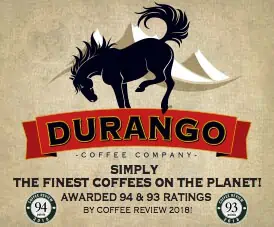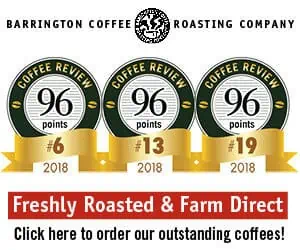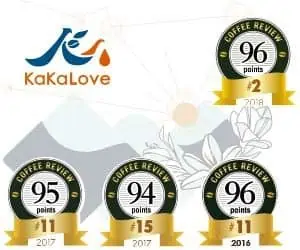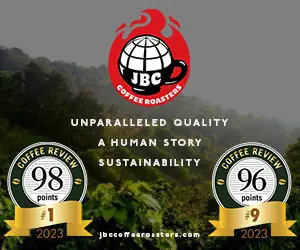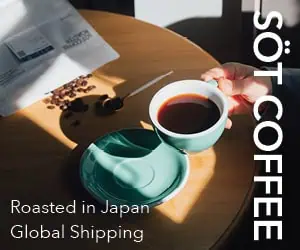The challenge: The highest quality coffee is produced by large, technically sophisticated companies which do a much better job at delivering fresh, consistent, good-value coffees than do most of today’s smaller specialty roasting companies.
I find I need to parse this lengthy and loaded sentence in order to comment on it.
Quality in coffee is a multifaceted thing, in large measure because of what I called “the broken chain of custody” in my book Coffee Basics. The grower, who puts in the lion’s share of the work, can do everything right, only to have the coffee ruined during shipment. The roaster then optimizes the coffee’s potential – or ruins it through over- or under-roasting, blending, incorrect packaging or grinding. Even if all of these steps are done optimally, is the coffee sold fresh, brewed at the right dosage, in good equipment with soft water heated to ideal temperature, and if so is it consumed immediately? The chances of a given coffee reaching its full potential do indeed remind me of salmon swimming upstream!
Starting near the beginning of the seed-to-cup path, sourcing the best quality green coffee depends on having extensive training in cupping so as to be able to recognize it, and then having sufficient funds to secure it in a competitive marketplace. Small start-ups typically are long on passion but short on both expertise and cash, while large, publicly-traded corporations have plenty of both but usually use them in the service of supplying coffees of consistent mediocrity.
Freshness is something that needs to be defined, and it’s one of the biggest areas where small and large roasters alike tend to cut corners. If excellence is the standard – and it should be – then only whole bean coffee at room temperature within 5-7 days of roast deserves to be called “fresh,” and certainly only such coffee deserves the designation “freshly-roasted.”
To preserve freshness beyond this very short time frame requires a large investment in technology and packaging and rigorous, consistent use thereof. One needs not only oxygen-impermeable bags with one-way degassing valves but also vacuum-packaging machine costing in excess of $50,000 to get the oxygen content within the bag below 1% before sealing, as well as an oxygen headspace meter to test packaged coffee and other equipment. Whole bean coffee thus packaged can be indistinguishable from freshly-roasted (as defined above) coffee for 2-3 months, but many roasters cut corners, either by just buying pre-formed bags and sealing them without drawing a vacuum or back-flushing with inert gas (in which case the shelf life is the same as unprotected whole beans), or by packaging their coffee correctly and then shooting themselves in the foot (and screwing their customers) through ridiculous “best by” dates of 6 months, a year, or even longer. The first practice is pervasive among small, “boutique” roasters, the others endemic among the larger players.
As for ground coffee, if you are Nestlé you have the ability to take coffee from roasting all the way to a pressurized Nespresso capsule in a sub-1% oxygen environment, preserving almost all the coffee’s aroma through precise grinding on a state-of-the-art water-cooled roller mill grinder that by itself costs more than many craft roaster’s entire roasting plants. If, on the other hand, you’re buying great coffee but grinding it for your wholesale accounts on a well-worn Grindmaster or Ditting, quality for you is basically a fantasy, not the process with clearly defined and monitored parameters that is the definition of quality in a manufacturing context.
Overall I would say that clearly the peak experiences in coffee are offered by roasters who employ experienced buyers with good access to capital and established buying relationships and who either roast and deliver their coffee on a purely local basis or have invested in (and know how to use) the equipment essential to preserve freshness. As for consistent quality, that is clearly the province of medium-to-large sized companies who buy in large enough quantities, understand the art of blending and, last not least, have made the investment in personnel and roasting, packaging, grinding and quality control equipment to deliver coffees of consistent quality. The Scandinavian countries, Germany and Japan have many such companies, Illycaffè in Italy is rightly revered for its standards, and of course here in the U.S. there are numerous mid-sized roasters who also deliver very good (and occasionally great) coffees of a consistent standard at prices consumers are happy to pay every day.
In conclusion, being small, groovy, microlot-oriented and employing staff with the right number of piercings (and selling high-priced coffees) doesn’t guarantee quality, anymore than being medium-to-large sized and driven more by bottom-line considerations than raw passion guarantees mediocrity. As with most else in coffee, it’s much more complicated than that.
For another perspective on this challenge, click here to see how Kenneth Davids responds

